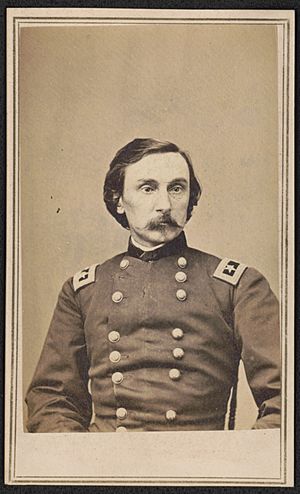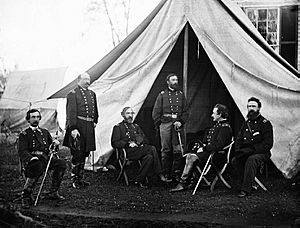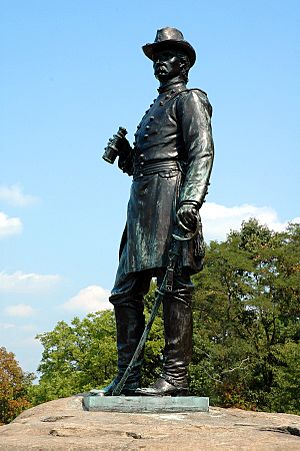Gouverneur K. Warren facts for kids
Quick facts for kids
Gouverneur Kemble Warren
|
|
|---|---|
| Nickname(s) | Hero of Little Round Top |
| Born | January 8, 1830 Cold Spring, New York, U.S. |
| Died | August 8, 1882 (aged 52) Newport, Rhode Island, U.S. |
| Place of burial |
Island Cemetery, Newport, Rhode Island
|
| Allegiance | United States |
| Service/ |
United States Army Union Army |
| Years of service | 1850–1882 |
| Rank | |
| Commands held | 5th New York Volunteer Infantry II Corps V Corps |
| Battles/wars | American Civil War |

Gouverneur Kemble Warren (born January 8, 1830 – died August 8, 1882) was an American civil engineer and a Union Army general during the American Civil War. He is best remembered for his quick thinking at the Battle of Gettysburg. There, he helped defend a very important hill called Little Round Top at the last minute. Because of this, he is often called the "Hero of Little Round Top." Later in his career, he commanded a large group of soldiers, but his military future was sadly affected during the Battle of Five Forks. He was removed from his command by General Philip Sheridan, who thought Warren was moving too slowly.
Contents
Early Life and Engineering Work
Warren was born in Cold Spring, New York. He was named after Gouverneur Kemble, a well-known local politician and businessman. His sister, Emily Warren Roebling, later played a big part in building the famous Brooklyn Bridge.
At 16, Warren joined the United States Military Academy at West Point. He graduated in 1850, ranking second in his class. He became a second lieutenant in the Corps of Topographical Engineers. This group focused on mapping and surveying land.
Before the Civil War, he worked on mapping the Mississippi River and surveying possible routes for transcontinental railroads. He even created the first detailed map of the United States west of the Mississippi River in 1857. This work included exploring vast areas like Nebraska, North Dakota, South Dakota, and parts of Montana and Wyoming.
One area he surveyed was the Minnesota River Valley. He was the first to explain that this huge valley was formed by a massive ancient river. This river drained a giant prehistoric lake called Lake Agassiz thousands of years ago. This great river was later named Glacial River Warren in his honor.
Civil War Service
When the Civil War began, Warren was a first lieutenant and a math teacher at West Point. He helped create a local regiment for the Union Army. On May 14, 1861, he became a lieutenant colonel of the 5th New York Volunteer Infantry. Warren and his regiment first saw combat at the Battle of Big Bethel in Virginia on June 10, 1861. This was one of the first major land battles of the war. He was promoted to colonel on September 10.
Early Campaigns
In 1862, during the Peninsula Campaign, Warren commanded his regiment at the Siege of Yorktown. He also helped the chief engineer of the Army of the Potomac by leading scouting missions and drawing detailed maps. These maps helped the army advance. He commanded a small group of soldiers (a brigade) during the Seven Days Battles. At the Battle of Gaines' Mill, he was hurt in the knee but stayed on the battlefield. He continued to lead his brigade at the Second Battle of Bull Run and the Battle of Antietam.

Warren was promoted to brigadier general on September 26, 1862. He and his brigade went to the Battle of Fredericksburg in December, but they were kept in reserve and did not fight. In February 1863, when Maj. Gen. Joseph Hooker reorganized the Army of the Potomac, he made Warren his chief engineer. Warren was praised for his work as chief engineer during the Battle of Chancellorsville.
Hero of Little Round Top
At the start of the Gettysburg Campaign, Warren advised General Hooker on the best routes for the army to follow. On the second day of the Battle of Gettysburg, July 2, 1863, Warren played a crucial role. He saw that a key position called Little Round Top was undefended on the Union Army's left side. On his own, he quickly sent Colonel Strong Vincent's brigade to occupy it. They arrived just minutes before the Confederates attacked. Warren himself suffered a minor neck wound during the Confederate attack. His quick actions saved the Union flank.
Later Commands and Challenges
After Gettysburg, Warren was promoted to major general on August 8, 1863. He commanded the II Corps from August 1863 to March 1864. He performed well at the Battle of Bristoe Station. On March 13, 1865, he was given a special promotion (brevet) to major general in the regular army for his actions at Bristoe Station.
During the Mine Run Campaign, Warren's corps was ordered to attack. However, he believed it was a trap and refused the order from army commander Maj. Gen. George G. Meade. Although Meade was angry at first, he later admitted that Warren had been right.
In spring 1864, Warren took command of the V Corps. He led this corps through the Overland Campaign, the Siege of Petersburg, and the Appomattox Campaign. During these campaigns, Warren became known for his careful and thoughtful approach, like an engineer. He won the Battle of Globe Tavern (August 18-20, 1864), which cut off a vital supply route to Petersburg. He also had some success at the Battle of Peebles's Farm in September 1864.
Conflict with Sheridan
General Philip Sheridan, a key leader under Lieutenant General Ulysses S. Grant, was not happy with Warren's performance. Sheridan thought Warren's corps moved too slowly after the Battle of the Wilderness and was too cautious during the Siege of Petersburg. At the start of the Appomattox Campaign, Grant gave Sheridan permission to remove Warren from command if he felt it was necessary. Grant later wrote in his memoirs:
I was so much dissatisfied with Warren’s dilatory movements in the battle of White Oak Road and in his failure to reach Sheridan in time, that I was very much afraid that at the last moment he would fail Sheridan. He was a man of fine intelligence, great earnestness, quick perception, and could make his dispositions as quickly as any officer, under difficulties where he was forced to act. But I had before discovered a defect which was beyond his control, that was very prejudicial to his usefulness in emergencies like the one just before us. He could see every danger at a glance before he had encountered it. He would not only make preparations to meet the danger which might occur, but he would inform his commanding officer what others should do while he was executing his move.
– Ulysses S. Grant, Personal Memoirs
At the Battle of Five Forks on April 1, 1865, Sheridan felt that the V Corps moved too slowly into the attack. He strongly criticized Warren for not being at the front of his columns. Warren had been delayed while looking for a division that had gotten lost in the woods. Despite this, Warren had handled his corps well, and their attack had won the day at Five Forks, which was a very important battle in the final days of the war. Nevertheless, Sheridan removed Warren from command right there on the spot. Warren was then assigned to the defenses of Petersburg and later briefly to command the Department of Mississippi.
After the War
Feeling humiliated by Sheridan's actions, Warren resigned his commission as a major general of volunteers on May 27, 1865. He returned to his permanent rank as a major in the United States Army Corps of Engineers. He served as an engineer for 17 years, building railroads and working along the Mississippi River. He reached the rank of lieutenant colonel in 1879. However, his promising military career was damaged.
Warren urgently asked for an official investigation to clear his name from the shame of Sheridan's actions. Many of his requests were ignored until Ulysses S. Grant retired from being president. President Rutherford B. Hayes ordered a court of inquiry, which began in 1879. After hearing from many witnesses over 100 days, the court found that Sheridan's decision to remove Warren had been unjustified. On November 21, 1881, President Chester A. Arthur ordered that these findings be made public. Sadly for Warren, the results were not published until after he died.
In 1867, he was chosen as a member of the American Philosophical Society, a group that promotes useful knowledge.
Warren's last job in the Army was as a district engineer in Newport, Rhode Island. He died there from complications of diabetes on August 8, 1882. He was buried in the Island Cemetery in Newport. At his request, he was buried in civilian clothes and without military honors. His last words were, "The flag! The flag!"
Legacy
A bronze statue of Warren stands on Little Round Top in Gettysburg National Military Park. It was created by Karl Gerhardt and dedicated in 1888. Another bronze statue, by Henry Baerer, was placed in the Grand Army Plaza in Brooklyn, New York. This statue shows Warren in uniform, holding binoculars, on a granite base made of stone from Little Round Top.
Many streets in new areas of Washington, D.C., were named after Civil War generals. An east-west street in the Northwest part of the city is named Warren Street, NW.
The United States Army Transport Warren was named after General Warren.
The G. K. Warren Prize is awarded about every four years by the National Academy of Sciences. This prize is funded by a gift from his daughter, Miss Emily B. Warren, in memory of her father.
See also
 In Spanish: Gouverneur K. Warren para niños
In Spanish: Gouverneur K. Warren para niños


